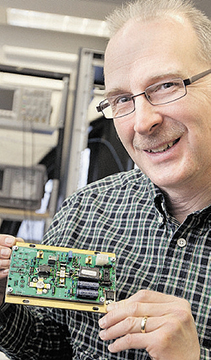News & Events
ISAS researcher Glenn Hussey to study lower region of ionosphere
The following article about Glen Hussey, a professor in the Department of Physics and Engineering Physics, and his research appeared in The StarPhoenix and The LeaderPost on Jan. 11, 2014. Read the original article here.
Building his own radar system first
By Betty Ann Adam, The StarPhoenix, January 11, 2014
 U of S Prof. Glenn Hussey displays one of three modules he is designing for a new digital radar transmitter and receiver system for gathering better data for mapping the ionosphere in near-Earth space.
U of S Prof. Glenn Hussey displays one of three modules he is designing for a new digital radar transmitter and receiver system for gathering better data for mapping the ionosphere in near-Earth space.
Photograph by: Gord Waldner, The Starphoenix
A University of Saskatchewan researcher wants to make detailed observations of the lower region of the ionosphere, but he'll have to design and build his own customized radar system to do it.
Professor Glenn Hussey, a near-Earth space physicist and engineering physicist, has received funding from the Canadian Foundation for Innovation (CFI) to take on the ambitious project over the next two years.
Hussey will use the digital radar transmitter and receiver system he creates to gather better data than is currently used for mapping the E-region of the ionosphere, about 100 kms above the Earth, where neutral atmosphere meets outer space.
The E-region is the area where charged particles cause the aurora we see in the night sky. Hussey's project will measure the density of the invisible ionized structures in the E-region.
"There's structure in there. When you and I look at the aurora, we see structure. What we're trying to do is (measure) what you see optically, but with a radar ... It's going to tell how about how these density structures are made up there." The project is a combination of nuts-and-bolts engineering and pure scientific inquiry.
"I'm always half a foot in engineering and half a foot in physics. It takes a lot of time to undertake a scientific experiment when you're building and debugging it, and then you have to analyze the data," he said.
"The experimental observations lead to understanding the physics better. You publish it and hopefully somebody, a modeller, picks it up and sticks it in a computer generated model." Scientists who make models will be able to use Hussey's new, greater understanding of particle motion in the E-region to create more accurate renderings to help predict space weather that can affect power grids, pipelines, telecommunications and satellite technologies.
Hussey said scientists looking at the ionosphere 100 years ago thought it was smooth and unstructured, but as technology improved they saw increasing detail. Today's digital radio techniques have revolutionized science's ability to gather information about the scattering of electromagnetic waves bounced off particles in the E-region.
There are a few places in the world that could custom build the sort of radar Hussey will need, but it's more affordable for him and a graduate student, Devin Huyghebaert, to use their own expertise to design and modify components and piece them together.
Hussey also relies on the expertise of his engineering colleagues in the Institute of Space and Atmospheric Studies (ISAS) in the Department of Physics and Engineering Physics.
Hussey's transmitter will be installed in a shack in northern Alberta beside 10 huge antennas. The receiver will be located on a few acres of rented land near Saskatoon, alongside 10 more antennas.
Hussey will take data from each receiver antenna and digitize it, creating a more detailed image than ever before.
By placing the transmitter and receiver hundreds of kilometres apart, the system will obtain both high time resolution and spatial resolution, meaning it will use radar waves to map or image the E-region, giving us a view similar to the structures we see optically when we view the aurora in the night sky. badam@thestarphoenix.com
© Copyright (c) The Regina Leader-Post